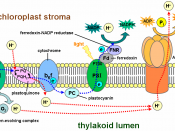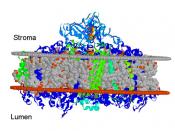Photosynthesis is the conversion of light energy to chemical energy. I occurs in two stages. These are the light reactions and the dark reactions.
The light reaction takes place in the thylakoids. In the light reaction, light energy strikes antennae pigments of photosystem II, which contains several hundred molecules of chlorophyll a and chlorophyll b. Electrons are then boosted uphill from the reactive chlorophyll a molecule P680 to a primary electron acceptor. As the electrons are removed, they are replaced by electrons from water molecules.
Simultaneously, free oxygen and protons are released. The electrons then pass downhill to photosystem 1 along an electron transport chain. This generates a proton gradient that drives the synthesis of ATP from ADP. ATP is formed by a chemiosmotic process. The light energy absorbed in the pigments of photosystem 1 and passed to P700 result in the boosting of electrons to another primary electron acceptor from which they are passed to NADP to form NADPH. The electrons that are removed from P700 are replaced by the electrons from photosystem II. These electrons are accepted by the electron carrier NADP. As a result of the light reactions, the energy of light which was converted to chemical energy is stored in the bonds of NADPH and in the ATP formed by phosphorylation.
The dark reaction occurs in the stroma. In the dark reaction, the NADPH and ATP produced in the light reactions are used to reduce carbon dioxide to organic carbon. This is accomplished through the Calvin Cycle. The cycle begins when carbon dioxide is combined with ribulose biphosphate. RuBP is a five carbon sugar which is the starting material for the Calvin Cycle. The RuBP then splits, forming two molecules of phosphoglycerate(PGA). At each full turn of the cycle, a molecule of...


